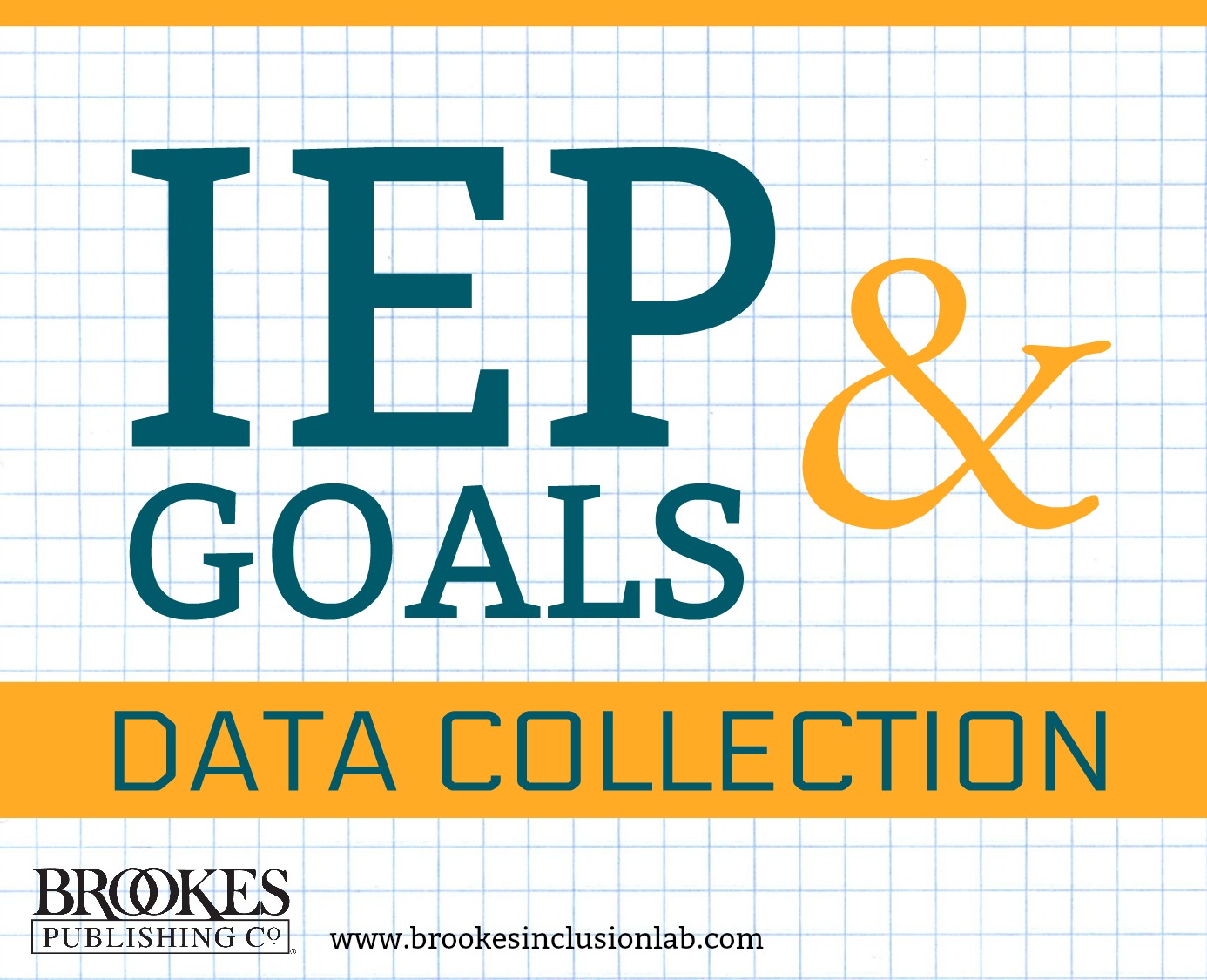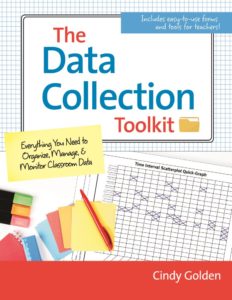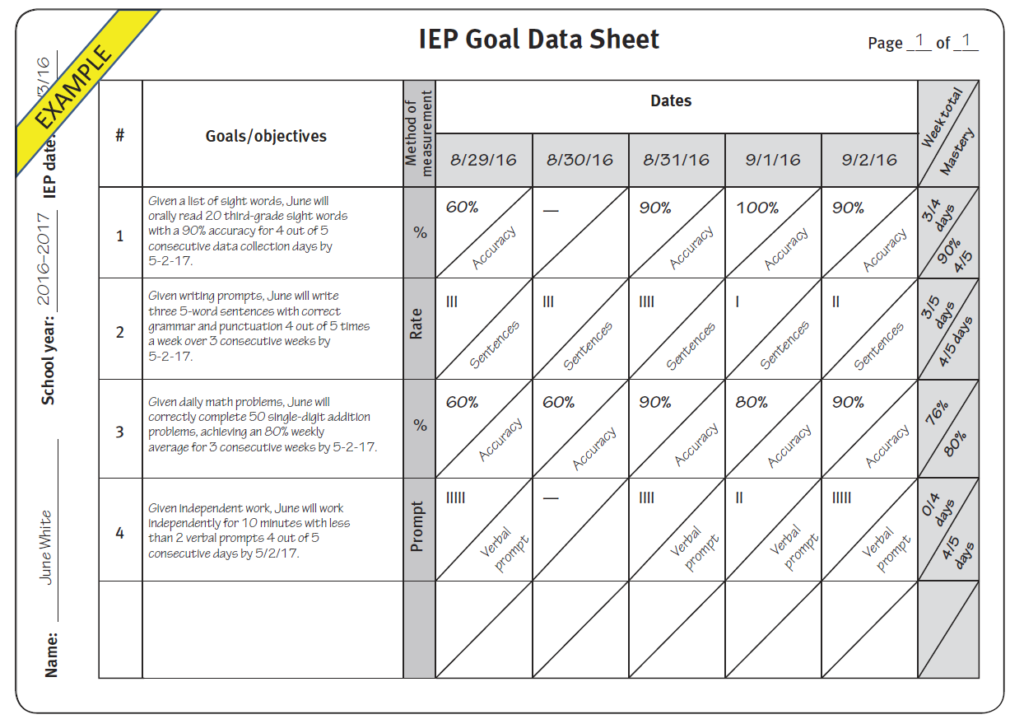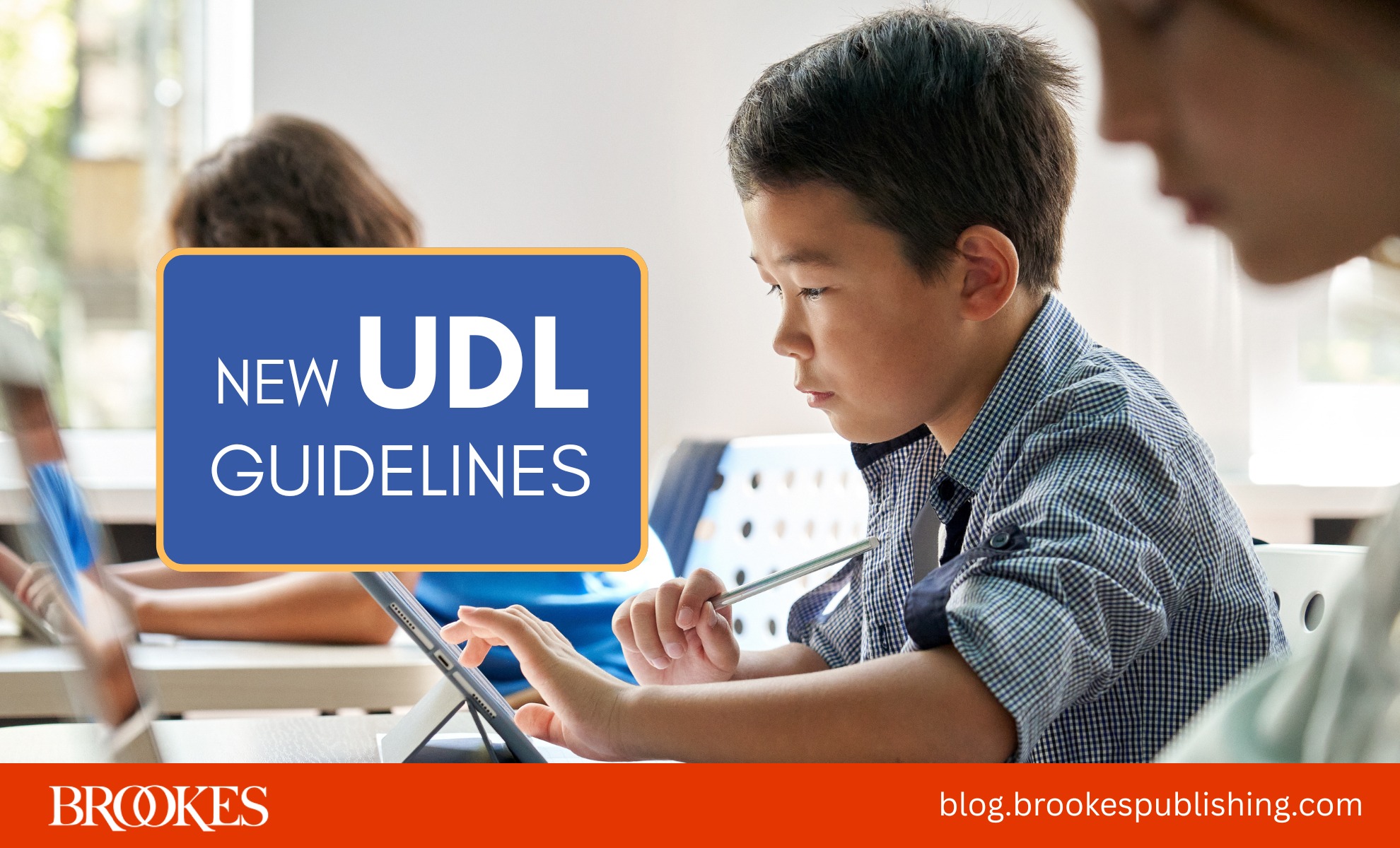Practical Tips for Better IEP Goals and Data Collection
November 28, 2017
When you’re working with students who have IEPs, it’s important to write specific and measurable IEP goals, collect good data, and keep the data organized. Today’s post gives you some tips you can use to improve your IEP process. Excerpted and adapted from Cindy Golden’s new book, The Data Collection Toolkit, this post is a starting point for writing better IEP goals and putting a solid data collection system in place.
Let’s start with two sample scenarios Golden offers in her book. Read them and see which one sounds more like your current process:
Scenario 1: Mr. and Mrs. Mulhern, I would like to talk about Regina’s IEP goals. If you look at Goal 1, you see that the mastery level for basic math facts was set at 75%, and I would guess that she began the year at about . . . maybe 50%? During the first 3 weeks, she seemed to make progress. She was learning her math facts and did pretty well on most of the work. But she did fail a test. Did you get that test I sent home? Overall, though, I think Regina’s doing well. I really love her; she’s such a sweet girl. We did take lots of data, but I think I must have left those data sheets in the room. I have nearly 100 of them, and they are pretty hard to carry. So, we probably should just keep the math goal on Regina’s IEP because I don’t think she’s quite mastered it yet. What do you think? Maybe if you could help her with her homework and her studying, we could get rid of that goal during our next IEP meeting.
Scenario 2: Mr. and Mrs. Mulhern, I would like to talk about the data that we have been collecting on Regina’s four IEP goals. If you look at Goal 1, shown in red, you will see that the mastery level for basic math facts was set at 75%, and her baseline data showed that she began at the 45% mastery level. During the first 3 weeks, she stayed at a pretty consistent level, but you can see that around January 19 she began to rapidly make gains. Regina really began to grasp her math concepts, and she ended up achieving the mastery level that we set for her by the first week of February. That is remarkable! Here are analyzed work samples that are shown by the data points on this graph. Do you see the upward trend shown on this graph? I put copies of the data and graphs in a folder of IEP handouts to take home.
Number 2 sounds better, right? What did the teacher in the first scenario do wrong? Golden points out that this educator:
- didn’t bring the data sheets to the meeting
- didn’t summarize, analyze, and graph the data
- had to guess at the baseline level
- said “she’s such a sweet girl”–which may be true, but can sound like the teacher is covering up for not being prepared
- said the vague phrase “she seemed to make progress” without explaining the evidence to the parents
- put the responsibility (or blame) back on the parents by saying, “if you could help her with homework…”
By contrast, the teacher in the second scenario did lots of things right. This teacher:
- clearly summarized and graphed the data
- calculated baseline levels and compared them to the student’s mastery level
- showed and explained the trendline
- brought analyzed work samples and matched them to data points
- provided the parents with a copy of the data and graphs
So how can you make sure your interactions are more like Scenario 2? There are two essential things to do: write measurable IEP goals or objectives and then organize a system for collecting data on these goals and objectives.
Write measurable IEP goals or objectives
Good data collection depends on having a measurable goal to work toward. Write IEP goals correctly, and it should be fairly easy to figure out which data collection method you should use. The data you gather should then inform your IEP decisions as you monitor the student’s progress.
Writing a measurable IEP goal can be summarized as a four-step process. To remember the steps, just think of the acronym GOAL:
- Given. Use this word at the beginning of the goal to set the condition. Given a journal prompt, Sarah will . . .
- Observable. Next, use an action word to clearly identify the behavior you’re measuring. Given a journal prompt, Sarah will orally read . . .
- A target is set. Set the criterion for exactly what the student should do to meet the goal: how much, how often, at what level. Given a journal prompt, Sarah will orally read 90 words per minute with 3 or fewer errors . . .
- Limit time. By when should the student master the goal? Given a journal prompt, Sarah will orally read 90 words per minute with 3 or fewer errors by the end of the 2017″“2018 school year.
Address all the components contained in the acronym, and you’ll have a well-written goal for your student to work toward!
Organize a system for collecting data
Golden identifies three main types of criteria used to measure goals:
- Rate: The student must repeat the task or behavior to demonstrate mastery. Example: Tarik will correctly complete 4 out of 5 assignments. Danae will correctly answer 15 single-digit addition facts within 5 minutes.
- Time: The student must complete the task within a specified time limit.
- Percentage: The student’s level of performance is measured relative to 100%. Example: Anna will give her correct phone number in 90% of the opportunities.
Remember to consider each student’s goals–and each individual child–before determining whether rate, time, or percentage is the best way to measure mastery.
Once you decide how your goals will be measured, you can keep track of them using a tool like Cindy Golden’s IEP Goal Data Sheet, a customizable form you can complete weekly to record progress for any type of IEP goal. The IEP Goal Data Sheet gives you space to list each goal, indicate which method of measurement you’re using, and track student progress on IEP goals for each day of the week. You can then record the student’s weekly total progress and compare it to the criteria for mastery.
Here’s an example of a completed IEP Goal Data Sheet for a student named June:
Goals and objectives are filled in on the left, and the specific methods used to measure each goal are indicated in the shaded gray column. As you can see, two of June’s IEP goals measure progress using percentages, her second goal uses a frequency count, and her last goal uses the number of prompts she is given to track her progress toward working independently for 10 minutes. June didn’t reach mastery level for any of her IEP goals during this week, but as the form indicates, she’s aiming for mastery by the end of the IEP year on May 2.
***
Hope this post gave you some helpful tips for setting and measuring IEP goals and objectives. To learn more (and get a reproducible version of the IEP Goal Data sheet and many more data collection tools), check out Cindy Golden’s Data Collection Toolkit. Read the reviews and get a free excerpt at the link below!






Write a Comment
Your email address will not be published. Required fields are marked *
comments
Lisa says
I like the goals you put on the example data sheet, but what would the objectives be for each goal? That is where I get confused. We never take data for progress reports on the goals....it’s each objective. I wish I could see an example of the objectives you would put with a goal like the sample ones to know if this is the right book for me. Thank you !
jlillis says
Hi Lisa,
Thank you for your question. I referred back to the chapter from which this post was adapted, and it doesn’t seem to give specific examples of how to break down the goals in the chart into smaller steps. IEP data collection is just one chapter in the book, so a more granular breakdown may have been beyond its scope. The book is a broader guide to the methods and procedures involved in data collection, analysis, and followup. You can review the complete TOC and get an excerpt of the book here: https://products.brookespublishing.com/The-Data-Collection-Toolkit-P1036.aspx That might give you a feel for what’s covered in the book and what the writing is like. Thanks again for commenting!
Janniffer Bailey says
This was very helpful.
jlillis says
Thank you, Janniffer! I'm glad you found the information useful.
Janniffer Bailey says
Again this was helpful. When I attend ARD meetings in the future,I will be more aware of what I'm actually looking at.
Janniffer Bailey says
The book was helpful . It really broke things down to where you can better understand .
Cheryl L Fancher says
Thank you for the information.
Ursula Merrick says
This part of the book was vey informative.
Brenda Russell says
This was VERY helpful, and this is a resource(book) I'd love to have!!
jlillis says
thank you for reading, Brenda! I'm glad it helped!
Robert Roszak says
One of the most crucial tools in a student’s school experience is their individulized education program (IEP). An effective IEP provides a blueprint for instruction and gets parents and educators on the same page.
melba j rader says
This is very helpful. The overview of writing IEP Goals is easy to follow.
jlillis says
thank you for reading! We're glad it was useful to you.
William Johnsn says
This was a good review for me giving practical information to be used in IEP goal writing
jlillis says
Thank you for reading! We're glad it was helpful!
Bryant, Barbara says
Great resource. It really made me stop and think about what I could I do better when writing my next goals and objectives.
Paul Kino says
This was a great review to kick off the year.
Travis M says
Excellent information
chay wilder says
Great advice. The action words used for writing goals and data collection make it easier to write/set goals that are measurable.
JIMMIE THOMAS says
This was very beneficial for me to begin the school year.
Thanks,
J. Thomas
Chad Kuntschik says
This was very helpful. Thanks you!
Tiffany Colbert says
I find this guide to be very helpful. I have often times tried to fogure out a way to ensure that I hae every element of a goal and the acronym would help me with that. Also, the guideline chart helps you keep track of the rates and frequency of how often a student performs the action in order to monitor progress.
Chad Henkelman says
I really enjoyed the refresher!
Kimberlee Taylor says
The information was valuable
Post a Comment